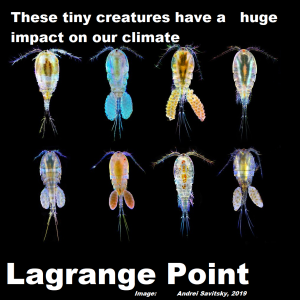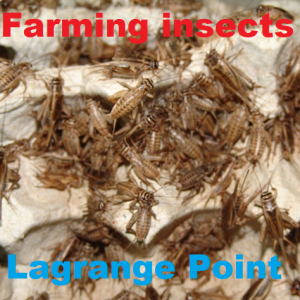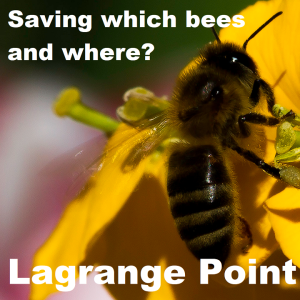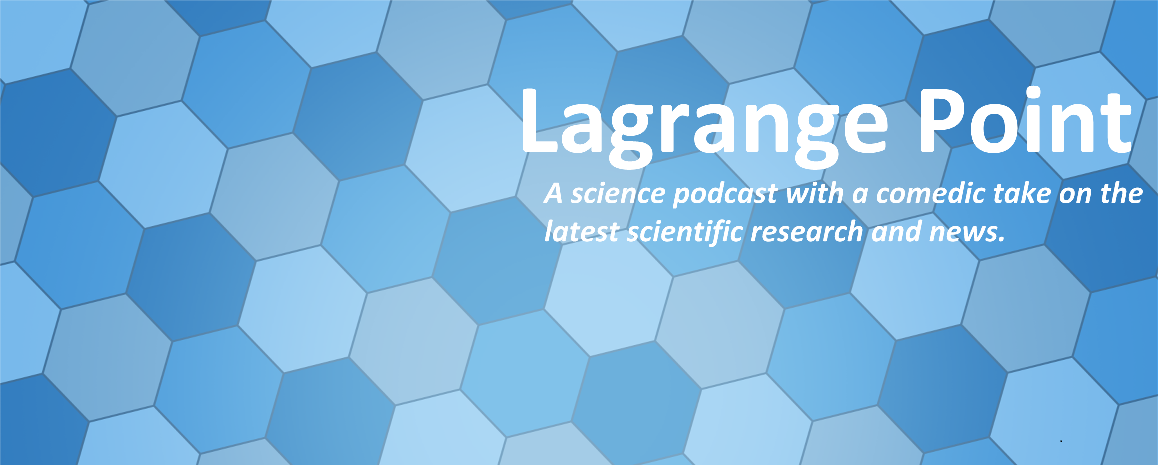Episodes

Monday Aug 16, 2021
Episode 444 - Deadly Creatures in Australia for Nat. Sci Week
Monday Aug 16, 2021
Monday Aug 16, 2021
It's National Science Week in Australia so we celebrate with some Aussie Science. What's more Aussie than dangerous creatures? Queensland Museum researchers have found even more spiders in Brisbane. Golden Trapdoors sound like they contain treasure, but since it's Australia we're talking about, its just another scary creature. Your average Brisbane backyard may contain more types of spiders than you imagine. How did snakes evolve their deadly fangs? What came first the venom or the tooth? Why have so many different snakes evolved venom where Lizards haven't? In Australia even the plants can be deadly. We know tobaccos is dangerous, but in WA scientists have found an insect eating wild tobacco plant. Wild tobacco plants can thrive in odd places in Australia and can even chow down on Insects.
- Wilson, J. D., & Rix, M. G. (2021). Systematics of the AUSTRALIAN golden trapdoor spiders of the EUOPLOS VARIABILIS-GROUP (Mygalomorphae : IDIOPIDAE : Euoplini): Parapatry And Sympatry between closely related species in SUBTROPICAL QUEENSLAND. Invertebrate Systematics. https://doi.org/10.1071/is20055
- Chase, M. W., & Christenhusz, M. J. (2021). 994. NICOTIANA INSECTICIDA: Solanaceae. Curtis's Botanical Magazine. https://doi.org/10.1111/curt.12402
- Palci, A., LeBlanc, A., Panagiotopoulou, O., Cleuren, S., Mehari Abraha, H., Hutchinson, M., Evans, A., Caldwell, M. and Lee, M., 2021. Plicidentine and the repeated origins of snake venom fangs. Proceedings of the Royal Society B: Biological Sciences, 288(1956), p.20211391.

Monday Jul 12, 2021
Episode 439 - The journey of humanity and its closet cousins
Monday Jul 12, 2021
Monday Jul 12, 2021
What separates Homo Sapiens from our closest cousins? How do we piece together the journey of Homo Sapiens across the world? Neanderthals were capable of much more than what stereotypes suggest. How did Neanderthals produce complex art? How did Neanderthals and Homo Sapiens intermix? Was there a linking population that helped spread Homo Sapiens genes into Neanderthals long before mass migration? Neanderthals are often thought of as Europe based, but was there a larger progenitor population in the Levant?
- Mooallem, J. (2021). The Sunday Read: ‘Neanderthals Were People, Too’. Retrieved 11 July 2021, from https://www.nytimes.com/2021/05/23/podcasts/the-daily/neanderthals-were-people-too.html
- Dirk Leder, Raphael Hermann, Matthias Hüls, Gabriele Russo, Philipp Hoelzmann, Ralf Nielbock, Utz Böhner, Jens Lehmann, Michael Meier, Antje Schwalb, Andrea Tröller-Reimer, Tim Koddenberg, Thomas Terberger. A 51,000-year-old engraved bone reveals Neanderthals’ capacity for symbolic behaviour. Nature Ecology & Evolution, 2021; DOI: 10.1038/s41559-021-01487-z
- Israel Hershkovitz, Hila May, Rachel Sarig, Ariel Pokhojaev, Dominique Grimaud-Hervé, Emiliano Bruner, Cinzia Fornai, Rolf Quam, Juan Luis Arsuaga, Viktoria A. Krenn, Maria Martinón-Torres, José María Bermúdez De Castro, Laura Martín-Francés, Viviane Slon, Lou Albessard-Ball, Amélie Vialet, Tim Schüler, Giorgio Manzi, Antonio Profico, Fabio Di Vincenzo, Gerhard W. Weber, Yossi Zaidner. A Middle Pleistocene Homo from Nesher Ramla, Israel. Science, 2021; 372 (6549): 1424-1428 DOI: 10.1126/science.abh3169
- Yossi Zaidner, Laura Centi, Marion Prévost, Norbert Mercier, Christophe Falguères, Gilles Guérin, Hélène Valladas, Maïlys Richard, Asmodée Galy, Christophe Pécheyran, Olivier Tombret, Edwige Pons-Branchu, Naomi Porat, Ruth Shahack-Gross, David E. Friesem, Reuven Yeshurun, Zohar Turgeman-Yaffe, Amos Frumkin, Gadi Herzlinger, Ravid Ekshtain, Maayan Shemer, Oz Varoner, Rachel Sarig, Hila May, Israel Hershkovitz. Middle Pleistocene Homo behavior and culture at 140,000 to 120,000 years ago and interactions with Homo sapiens. Science, 2021; 372 (6549): 1429-1433 DOI: 10.1126/science.abh3020
- Marta Mirazón Lahr. The complex landscape of recent human evolution. Science, 2021; 372 (6549): 1395-1396 DOI: 10.1126/science.abj3077

Monday Jun 28, 2021
Episode 437 - Dark Fish hiding in the ocean depths
Monday Jun 28, 2021
Monday Jun 28, 2021
Squeezing and grinding to create next generation materials from humble beginnings. Changing magnetic field by changing shape could open the door for more efficient computers. Magnetostriction causes that 'hum' you hear from electronics but it can be harnessed for good. Large electrical devices like transformers or fluorescent tubes shape influences their magnetic field. The next generation of computers may harness the way magnetic fields and physical shape can be linked. Forget rare earth metals, there is a more efficient way to make high powered computer chips out of humble iron and gallium. Luminescent polymers can be found in fancy OLED screens but are complex to produce. How can you make fancy luminescent polymers from generic polymers? By grinding them. A unique way of grinding and rolling basic generic polymers could create powerful luminescent polymers for use in high end screens, lasers and bioimaging.
- P. B. Meisenheimer, R. A. Steinhardt, S. H. Sung, L. D. Williams, S. Zhuang, M. E. Nowakowski, S. Novakov, M. M. Torunbalci, B. Prasad, C. J. Zollner, Z. Wang, N. M. Dawley, J. Schubert, A. H. Hunter, S. Manipatruni, D. E. Nikonov, I. A. Young, L. Q. Chen, J. Bokor, S. A. Bhave, R. Ramesh, J.-M. Hu, E. Kioupakis, R. Hovden, D. G. Schlom, J. T. Heron. Engineering new limits to magnetostriction through metastability in iron-gallium alloys. Nature Communications, 2021; 12 (1) DOI: 10.1038/s41467-021-22793-x
- Koji Kubota, Naoki Toyoshima, Daiyo Miura, Julong Jiang, Satoshi Maeda, Mingoo Jin, Hajime Ito. Introduction of a Luminophore into Generic Polymers via Mechanoradical Coupling with a Prefluorescent Reagent. Angewandte Chemie International Edition, 2021; DOI: 10.1002/anie.202105381

Monday Jun 14, 2021
Episode 435 - Cold war secrets and reanimating frozen life
Monday Jun 14, 2021
Monday Jun 14, 2021
Cold war secrets buried deep in the ice and forgotten, plus reanimating frozen life from Siberia. How could some frozen dirt, forgotten in a freezer for decades help us understand a future of rising sea levels? Greenland's name was a marketing stunt by Erik the Red, but it was once truly covered in greenery. Although Greenland is so close to the North Pole, all it's thick sheets of ice have completely melted (geologically) recently. How did scientists reanimate ancient animals buried in the Siberian Tundra? Rotifers can live in some unusual places, but they can also survive being frozen and brought back to life. Ancient animals have been 'unfrozen' and brought back to life though they are very small.
- Lyubov Shmakova, Stas Malavin, Nataliia Iakovenko, Tatiana Vishnivetskaya, Daniel Shain, Michael Plewka, Elizaveta Rivkina. A living bdelloid rotifer from 24,000-year-old Arctic permafrost. Current Biology, 2021; 31 (11): R712 DOI: 10.1016/j.cub.2021.04.077
- Baqai, A., Guruswamy, V., Liu, J., & Rizki, G. (2000). Introduction to the Rotifera. Retrieved 10 June 2021, from https://ucmp.berkeley.edu/phyla/rotifera/rotifera.html
- Andrew J. Christ, Paul R. Bierman, Joerg M. Schaefer, Dorthe Dahl-Jensen, Jørgen P. Steffensen, Lee B. Corbett, Dorothy M. Peteet, Elizabeth K. Thomas, Eric J. Steig, Tammy M. Rittenour, Jean-Louis Tison, Pierre-Henri Blard, Nicolas Perdrial, David P. Dethier, Andrea Lini, Alan J. Hidy, Marc W. Caffee, John Southon. A multimillion-year-old record of Greenland vegetation and glacial history preserved in sediment beneath 1.4 km of ice at Camp Century. Proceedings of the National Academy of Sciences, 2021; 118 (13): e2021442118 DOI: 10.1073/pnas.2021442118

Monday Apr 05, 2021
Episode 425 - Tiny creatures with a huge impact on our oceans
Monday Apr 05, 2021
Monday Apr 05, 2021
Can you find fresh water in the middle of the ocean? What happens when a geyser of fresh water erupts from the sea floor into the ocean? A sudden freshwater spring can radically change the ocean floor. How do plankton shells and coral help us monitor a changing climate? Life in the oceans can help sequester carbon. We can track the way the climate has changed in the past by studying strontium isotopes in seawater. Changing climates can impact life in shallow and deep water, which can lead to changes in the carbon cycle. Tiny creatures like copepods can have a huge impact on our ocean food web. How do tiny creatures like copepods gather in ephemeral ocean zephyrs. Tiny vortexs can act as a gathering place for tiny but important sea creatures.
- Eric Attias, Steven Constable, Dallas Sherman, Khaira Ismail, Christopher Shuler, Henrietta Dulai. Marine Electromagnetic Imaging and Volumetric Estimation of Freshwater Plumes Offshore Hawai'i. Geophysical Research Letters, 2021; 48 (7) DOI: 10.1029/2020GL091249
- Adina Paytan, Elizabeth M. Griffith, Anton Eisenhauer, Mathis P. Hain, Klaus Wallmann, Andrew Ridgwell. A 35-million-year record of seawater stable Sr isotopes reveals a fluctuating global carbon cycle. Science, 2021; 371 (6536): 1346 DOI: 10.1126/science.aaz9266
- Dorsa Elmi, Donald R. Webster, David M. Fields. Response of the copepod Acartia tonsa to the hydrodynamic cues of small-scale, dissipative eddies in turbulence. The Journal of Experimental Biology, 2021; 224 (3): jeb237297 DOI: 10.1242/jeb.237297

Monday Mar 15, 2021
Episode 422 - Squid blending into starlight with Bio-luminescent bacteria
Monday Mar 15, 2021
Monday Mar 15, 2021
Squid can change colours, reflect light and blend in with their surroundings. How does the changing colours on squid skin work? What proteins and structures enable squid skin to reflect and amplify varying light? Squid can blend themselves into the starlight with the aid of bio-luminescence. The symbiotic relationship between bacteria and squid starts right after birth, and helps them shine to avoid predators and catch prey. A baby squid may not start out bioluminescent but a rapid spread of the right bacteria turns on the lights.
- Katherine E. Zink, Denise A. Ludvik, Phillip R. Lazzara, Terry W. Moore, Mark J. Mandel, Laura M. Sanchez. A Small Molecule Coordinates Symbiotic Behaviors in a Host Organ. mBio, 2021; 12 (2) DOI: 10.1128/mBio.03637-20
- Daniel E. Morse, Esther Taxon. Reflectin needs its intensity amplifier: Realizing the potential of tunable structural biophotonics. Applied Physics Letters, 2020; 117 (22): 220501 DOI: 10.1063/5.0026546

Monday Mar 08, 2021
Episode 421 - March Mammal Madness '21 and Bats tuning out the world
Monday Mar 08, 2021
Monday Mar 08, 2021
We find out about the outreach and impact of March Mammal Madness. What happens when 65 animals face off for bragging rights? Find out in #2021MMM . By sharing science with a dramatic flair, #2021MMM has brought attention to 1000s of scientific papers. From 1% of US High school classrooms, to a global audience of young and old, #2021MMM shows how science does not have to be boring. How do bats tune out the background noise and hunt tiny prey? Using acoustic tunnel vision, bats are able to hone in on their tiny prey. By echoing quietly, bats can detect the smallest of bugs.
- Hinde, K., Amorim, C. E., Brokaw, A. F., Burt, N., Casillas, M. C., Chen, A., . . . Anderson, C. N. (2021). March mammal madness and the power of narrative in science outreach. ELife, 10. doi:10.7554/elife.65066
- Hinde, K. (et al..). March mammal madness: How to play. Retrieved March 06, 2021, from https://libguides.asu.edu/MarchMammalMadness#s-lg-box-23314477
- Hinde, K, March mammal Madness 2021. Retrieved March 06, 2021, from http://mammalssuck.blogspot.com/2021/02/march-mammal-madness-2021.html
- Laura Stidsholt, Stefan Greif, Holger R. Goerlitz, Kristian Beedholm, Jamie Macaulay, Mark Johnson, Peter Teglberg Madsen. Hunting bats adjust their echolocation to receive weak prey echoes for clutter reduction. Science Advances, 2021; 7 (10): eabf1367 DOI: 10.1126/sciadv.abf1367

Monday Sep 28, 2020
Episode 398 - Ig Nobel Prize '20 - Alligators and Spiders
Monday Sep 28, 2020
Monday Sep 28, 2020
We find out more about two more Ig Nobel prizes, for Accoustics and Entomology. Spiders aren't insects, but they're pretty similar. So why do so many entomologists fear spiders? Lots of legs, moves suddenly, weird shape, are fine for entomologists but add 2 extra legs and it's right out. Extra legs are a deal breaker for entomologists with a fear of spiders. Helium, Alligators in a tank, and resonant frequencies won this group a Ig Nobel prize. You've heard of beard song, but what about Alligator on helium song? Alligators and Birds can help us understand the songs of Dinosaurs.
- “A Chinese Alligator in Heliox: Formant Frequencies in a Crocodilian,” Stephan A. Reber, Takeshi Nishimura, Judith Janisch, Mark Robertson, and W. Tecumseh Fitch, Journal of Experimental Biology, vol. 218, 2015, pp. 2442-2447.
- “Arachnophobic Entomologists: When Two More Legs Makes a Big Difference,” Richard S. Vetter, American Entomologist, vol. 59, no. 3, 2013, pp. 168-175.

Monday Aug 24, 2020
Episode 393 - Microbial life in a teaspoon of the ocean
Monday Aug 24, 2020
Monday Aug 24, 2020
Life in the ocean is more than just fish, whales and squid, it goes down to a microbial level. We can learn a lot about the health of a whole reef system by studying microbial life in the water. Just one teaspoon of the ocean contains thousands of unique microbes. The ocean currents carry and mix ocean microbes. What makes a healthy reef? Well take a look at the microbes. How can nutrient and soil runoff damage a reef?
- Maria G. Pachiadaki, Julia M. Brown, Joseph Brown, Oliver Bezuidt, Paul M. Berube, Steven J. Biller, Nicole J. Poulton, Michael D. Burkart, James J. La Clair, Sallie W. Chisholm, Ramunas Stepanauskas. Charting the Complexity of the Marine Microbiome through Single-Cell Genomics. Cell, 2019; 179 (7): 1623 DOI: 10.1016/j.cell.2019.11.017
- Laura Weber, Patricia González‐Díaz, Maickel Armenteros, Víctor M. Ferrer, Fernando Bretos, Erich Bartels, Alyson E. Santoro, Amy Apprill. Microbial signatures of protected and impacted Northern Caribbean reefs: changes from Cuba to the Florida Keys. Environmental Microbiology, 2019; DOI: 10.1111/1462-2920.14870

Monday Jul 06, 2020
Episode 386 - T-rex, Raptors and Giant Squid go a hunting
Monday Jul 06, 2020
Monday Jul 06, 2020
How fast did T-Rex really go? Was it a sprinter or an endurance runner? Being chased by a T-Rex is scary, but you have to be ready for a marathon not a sprint. T-Rex's long legs helped it be efficient rather than speedy. Did raptors hunt in packs or just near each other? What links Komodo dragons and hunting raptors? Can we figure out if raptors hunted in packs by studying their teeth? Can Komodo dragons help bust Jurrassic Park myths? We also find out about an epic battle between Giant squid and a fish trapped for eternity as fossils.
- T. Alexander Dececchi, Aleksandra M. Mloszewska, Thomas R. Holtz, Michael B. Habib, Hans C. E. Larsson. The fast and the frugal: Divergent locomotory strategies drive limb lengthening in theropod dinosaurs. PLOS ONE, 2020; 15 (5): e0223698 DOI: 10.1371/journal.pone.0223698
- J.A. Frederickson, M.H. Engel, R.L. Cifelli. Ontogenetic dietary shifts in Deinonychus antirrhopus (Theropoda; Dromaeosauridae): Insights into the ecology and social behavior of raptorial dinosaurs through stable isotope analysis. Palaeogeography, Palaeoclimatology, Palaeoecology, 2020; 109780 DOI: 10.1016/j.palaeo.2020.109780
- University of Plymouth. (2020, May 6). Fossil reveals evidence of 200-million-year-old 'squid' attack. ScienceDaily. Retrieved May 15, 2020 from www.sciencedaily.com/releases/2020/05/200506133625.htm

Monday Jun 22, 2020
Episode 384 - Plants regenerating and fighting off invaders
Monday Jun 22, 2020
Monday Jun 22, 2020
How do plants manage to recover from damage or fungal attacks? What happens when you shoot a laser at some cress? Studying the way plants respond to damage helps us understand their regeneration methods. Plant cells can regenerate to recover from damage, but what controls this process? Fighting off a fungal invasion means an arms race between plants and fungus. Plants like cabbage use a special mustard oil bomb to fight back against fungal invaders. Fungal invaders like white mold can render even the most sophisticate plant defences useless.
- Lukas Hoermayer, Juan Carlos Montesinos, Petra Marhava, Eva Benková, Saiko Yoshida, Jiří Friml. Wounding-induced changes in cellular pressure and localized auxin signalling spatially coordinate restorative divisions in roots. Proceedings of the National Academy of Sciences, 2020; 202003346 DOI: 10.1073/pnas.2003346117
- Jingyuan Chen, Chhana Ullah, Michael Reichelt, Franziska Beran, Zhi-Ling Yang, Jonathan Gershenzon, Almuth Hammerbacher, Daniel G. Vassão. The phytopathogenic fungus Sclerotinia sclerotiorum detoxifies plant glucosinolate hydrolysis products via an isothiocyanate hydrolase. Nature Communications, 2020; 11 (1) DOI: 10.1038/s41467-020-16921-2

Monday Jun 08, 2020
Episode 382 - Animals keeping watch on our environment
Monday Jun 08, 2020
Monday Jun 08, 2020
Animals can help us monitor our environment for pollution. From silicon dog tags to tiger snakes in wetlands, animals can help us monitor pollution. How can silicon dog tags help protect humans from environmental pollutants? Cleaning up an oil spill is tricky, but with the right materials it's easy as wringing a sponge. Water hating but Oil loving magnetic sponges can help clean up after oil spills. How do Tiger snakes help us find the cleanest wetlands? Just how clean are urban wetlands?
- Catherine F. Wise, Stephanie C. Hammel, Nicholas Herkert, Jun Ma, Alison Motsinger-Reif, Heather M. Stapleton, Matthew Breen. Comparative Exposure Assessment Using Silicone Passive Samplers Indicates That Domestic Dogs Are Sentinels To Support Human Health Research. Environmental Science & Technology, 2020; DOI: 10.1021/acs.est.9b06605
- D. C. Lettoof, P. W. Bateman, F. Aubret, M. M. Gagnon. The Broad-Scale Analysis of Metals, Trace Elements, Organochlorine Pesticides and Polycyclic Aromatic Hydrocarbons in Wetlands Along an Urban Gradient, and the Use of a High Trophic Snake as a Bioindicator. Archives of Environmental Contamination and Toxicology, 2020; 78 (4): 631 DOI: 10.1007/s00244-020-00724-z
- Vikas Nandwana, Stephanie M. Ribet, Roberto D. Reis, Yuyao Kuang, Yash More, Vinayak P. Dravid. OHM Sponge: A Versatile, Efficient, and Ecofriendly Environmental Remediation Platform. Industrial & Engineering Chemistry Research, 2020; DOI: 10.1021/acs.iecr.0c01493

Monday Apr 27, 2020
Episode 376 - Learning from spider webs, venom and combs
Monday Apr 27, 2020
Monday Apr 27, 2020
What can we learn from spiders webs, venom and combs? How do spiders manage to weave intricate webs without getting tangled in them? How can spider's legs help develop next generation nano materials? How can spider venom help us fight back against the opioid crisis? Spider venom is dangerous but it can also help reduce harm in pain management.
- Akello J. Agwa, Poanna Tran, Alexander Mueller, Hue N. T. Tran, Jennifer R. Deuis, Mathilde R. Israel, Kirsten L. McMahon, David J. Craik, Irina Vetter, Christina I. Schroeder. Manipulation of a spider peptide toxin alters its affinity for lipid bilayers and potency and selectivity for voltage-gated sodium channel subtype 1.7. Journal of Biological Chemistry, 2020; 295 (15): 5067 DOI: 10.1074/jbc.RA119.012281
- Anna-Christin Joel, Marco Meyer, Johannes Heitz, Alexander Heiss, Daesung Park, Hana Adamova, Werner Baumgartner. Biomimetic Combs as Antiadhesive Tools to Manipulate Nanofibers. ACS Applied Nano Materials, 2020; 3 (4): 3395 DOI: 10.1021/acsanm.0c00130
- Po Peng, Devi Stuart‐Fox, Szu‐Wei Chen, Eunice J. Tan, Guan‐Lin Kuo, Sean J. Blamires, I‐Min Tso, Mark A. Elgar. High contrast yellow mosaic patterns are prey attractants for orb‐weaving spiders. Functional Ecology, 2020; DOI: 10.1111/1365-2435.13532

Monday Mar 23, 2020
Episode 371 - Marine Mammals vs Parasites
Monday Mar 23, 2020
Monday Mar 23, 2020
Its a battle between Marine Mammals and Parasites. How does an opossum parasite start killing sea otters? In #2020MMM unexpected combatants can ruin your day, just like how opossum parasites are taking out sea otters. How does a parasite make a long journey from land to end up out at sea? Inside raw fish, parasitic worm populations are booming. This is bad news for marine mammals. Conserving marine mammals can be a delicate balancing act as parasite populations can also start to thrive.
- Tristan L. Burgess, M. Tim Tinker, Melissa A. Miller, Woutrina A. Smith, James L. Bodkin, Michael J. Murray, Linda M. Nichol, Justin A. Saarinen, Shawn Larson, Joseph A. Tomoleoni, Patricia A. Conrad, Christine K. Johnson. Spatial epidemiological patterns suggest mechanisms of land-sea transmission for Sarcocystis neurona in a coastal marine mammaTl. Scientific Reports, 2020; 10 (1) DOI: 10.1038/s41598-020-60254-5
- Evan A. Fiorenza, Catrin A. Wendt, Katie A. Dobkowski, Teri L. King, Marguerite Pappaionou, Peter Rabinowitz, Jameal F. Samhouri, Chelsea L. Wood. It’s a wormy world: Meta-analysis reveals several decades of change in the global abundance of the parasitic nematodes Anisakis spp. and Pseudoterranova spp. in marine fishes and invertebrates. Global Change Biology, 2020; DOI: 10.1111/gcb.15048

Monday Feb 10, 2020
Episode 365 - Wasps, Bees, tasty meals and pesticide.
Monday Feb 10, 2020
Monday Feb 10, 2020
From wasps to bees how are insects adapting to a changing world. What type of food do bees prefer? Can a bee be a fussy eater? What makes a tasty meal for a Bee and what would they avoid like the plague? What changes can be introduced into the microbiome by pesticides? How can pesticides change the microbiome of wasps and develop into resistance? Can pesticide actually make lives harder for themselves by building tolerance in insects? How does an Asian hornet end up in Northern Europe?
- Wang et al. Changes in microbiome confer multigenerational host resistance after sub-toxic pesticide exposure. Cell Host & Microbe, 2020 DOI: 10.1016/j.chom.2020.01.009
- Martin Husemann, Andreas Sterr, Swen Mack, Rudolf Abraham. The northernmost record of the Asian hornet Vespa velutina nigrithorax (Hymenoptera, Vespidae). Evolutionary Systematics, 2020; 4 (1): 1 DOI: 10.3897/evolsyst.4.47358
- Fabian A. Ruedenauer, David Raubenheimer, Daniela Kessner‐Beierlein, Nils Grund‐Mueller, Lisa Noack, Johannes Spaethe, Sara D. Leonhardt. Best be(e) on low fat: linking nutrient perception, regulation and fitness. Ecology Letters, 2020; DOI: 10.1111/ele.13454

Monday Jan 20, 2020
Episode 362 - Life after a disaster from Fukashima to Chernobyl
Monday Jan 20, 2020
Monday Jan 20, 2020
What happens next after disaster strikes and people flee for safety? How do wildlife move in when people move out of a disaster zone? How do animals moving into an evacuated area change with no humans around? What is the most effective thing to do if you live near a disaster area? How do we assess risk and life expectancy impact of living near a disaster zone? Is it more dangerous to live near a nuclear plant or in the diesel smog of the big city?
- Phillip C Lyons, Kei Okuda, Matthew T Hamilton, Thomas G Hinton, James C Beasley. Rewilding of Fukushima's human evacuation zone. Frontiers in Ecology and the Environment, 2020; DOI: 10.1002/fee.2149
- Philip Thomas, John May. Coping after a big nuclear accident. Process Safety and Environmental Protection, 2017; 112: 1 DOI: 10.1016/j.psep.2017.09.013

Monday Dec 09, 2019
Episode 356 - Responding to signs of danger
Monday Dec 09, 2019
Monday Dec 09, 2019
How do animals communicate information about danger? When a threat is detected by one animal, how do they pass it along to others? Does empathy play a role in how a create responds to a threat? Does the reaction of others around you change your response to threats? What chemical causes you to freeze in response to danger? How does serotonin cause deer in the headlights moments? What's the link between serotonin and slowing down in response to danger?
- Yingying Han, Rune Bruls, Efe Soyman, Rajat Mani Thomas, Vasiliki Pentaraki, Naomi Jelinek, Mirjam Heinemans, Iege Bassez, Sam Verschooren, Illanah Pruis, Thijs Van Lierde, Nathaly Carrillo, Valeria Gazzola, Maria Carrillo, Christian Keysers. Bidirectional cingulate-dependent danger information transfer across rats. PLOS Biology, 2019; 17 (12): e3000524 DOI: 10.1371/journal.pbio.3000524
- Clare E. Howard, Chin-Lin Chen, Tanya Tabachnik, Rick Hormigo, Pavan Ramdya, Richard S. Mann. Serotonergic Modulation of Walking in Drosophila. Current Biology, 2019; DOI: 10.1016/j.cub.2019.10.042

Monday Aug 19, 2019
Episode 340 - Insects revolutionizing agriculture
Monday Aug 19, 2019
Monday Aug 19, 2019
Insects are often thought of as the enemy of farmers, but they can help improve farming. From helpful worm pheromones, to farming crickets and hungry termites. Worms can help boost the resilience of crops like wheat, corn and maize to common threats. Worm pheromones help plants fight back against bacteria, viral and fungal invaders. If insects are the super food of the future, how do you successfully farm them on a large scale? What nutrient rich feed do insect farms need to give their herds? If you are growing crickets and locusts do they need different food? What food is best for termites and how can they be used to help better manage forest?
References:
- Daniel F. Klessig, Murli Manohar, Shine Baby, Aline Koch, Wiseborn B. Danquah, Emily Luna, Hee‐Jin Park, Judith M. Kolkman, B. Gillian Turgeon, Rebecca Nelson, Jan E. Leach, Valerie M. Williamson, Karl‐Heinz Kogel, Aardra Kachroo, Frank C. Schroeder. Nematode ascaroside enhances resistance in a broad spectrum of plant–pathogen systems. Journal of Phytopathology, 2019; 167 (5): 265 DOI: 10.1111/jph.12795
- P. Straub, C.M. Tanga, I. Osuga, W. Windisch, S. Subramanian. Experimental feeding studies with crickets and locusts on the use of feed mixtures composed of storable feed materials commonly used in livestock production. Animal Feed Science and Technology, 2019; 255: 114215 DOI: 10.1016/j.anifeedsci.2019.114215
- Martin F. Jurgensen, Chris A. Miller, Carl T. Trettin, Deborah S. Page-Dumroese. Bedding of Wetland Soil: Effects of Bed Height and Termite Activity on Wood Decomposition. Soil Science Society of America Journal, 2019; 0 (0): 0 DOI: 10.2136/sssaj2018.12.0492

Monday Jul 29, 2019
Monday Jul 29, 2019
As the climate changes different species are at risk. Some will thrive and others will struggle, so how do we target conservation efforts to better protect at risk species? Deforestation is a big issue in developing countries, but is there a win-win for the population and the planet? When sea levels rise, we think about flooding and erosion, but not what will happen to the forests and birds who live in them. Trees in the city live fast and die young, which means we need a whole new set of forest management techniques.
References:
- Paul J. Taillie, Christopher E. Moorman, Lindsey S. Smart, Krishna Pacifici. Bird community shifts associated with saltwater exposure in coastal forests at the leading edge of rising sea level. PLOS ONE, 2019; 14 (5): e0216540 DOI: 10.1371/journal.pone.0216540
- C. David L. Orme, Sarah Mayor, Luiz dos Anjos, Pedro F. Develey, Jack H. Hatfield, José Carlos Morante-Filho, Jason M. Tylianakis, Alexandre Uezu, Cristina Banks-Leite. Distance to range edge determines sensitivity to deforestation. Nature Ecology & Evolution, 2019; DOI: 10.1038/s41559-019-0889-z
- Ian A. Smith, Victoria K. Dearborn, Lucy R. Hutyra. Live fast, die young: Accelerated growth, mortality, and turnover in street trees. PLOS ONE, 2019; 14 (5): e0215846 DOI: 10.1371/journal.pone.0215846
- Johan A. Oldekop, Katharine R. E. Sims, Birendra K. Karna, Mark J. Whittingham, Arun Agrawal. Reductions in deforestation and poverty from decentralized forest management in Nepal. Nature Sustainability, 2019; DOI: 10.1038/s41893-019-0277-3

Sunday Jun 30, 2019
Episode 333 - Saving which bees and where
Sunday Jun 30, 2019
Sunday Jun 30, 2019
Saving the bees has gotten widespread understanding, but it is more nuanced than a simple sound bite. Which bees are in danger and where? How many bee species are out there and are under threat? Can domesticated bees spread disease to wild populations? How do wild flowers help feed bees but also spread disease? Can different types of crop cycles help both wild and domesticated bees thrive? We know of colony collapse disorder and pesticides, but what other threats are out there to bee populations? Does the urban sprawl play a role in destabilising the gender balance of the bee populations? Why do bee populations drop off as you approach the city?
References:
- Samantha A. Alger, P. Alexander Burnham, Humberto F. Boncristiani, Alison K. Brody. RNA virus spillover from managed honeybees (Apis mellifera) to wild bumblebees (Bombus spp.). PLOS ONE, 2019; 14 (6): e0217822 DOI: 10.1371/journal.pone.0217822
- Dimitry Wintermantel, Jean-François Odoux, Joël Chadœuf, Vincent Bretagnolle. Organic farming positively affects honeybee colonies in a flower-poor period in agricultural landscapes. Journal of Applied Ecology, 2019; DOI: 10.1111/1365-2664.13447
- Gordon Fitch, Paul Glaum, Maria-Carolina Simao, Chatura Vaidya, Jill Matthijs, Benjamin Iuliano, Ivette Perfecto. Changes in adult sex ratio in wild bee communities are linked to urbanization. Scientific Reports, 2019; 9 (1) DOI: 10.1038/s41598-019-39601-8

